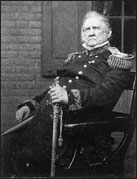Colonial Wars |
American Wars |
Link To This Page — Contact Us —
Major General Winfield Scott
 |
| NAME |
| Scott, Winfield |
| BORN |
| June 13, 1786 Petersburg, Virginia |
| DIED |
| May 29, 1866 West Point, New York |
| ARMY |
| Union |
Scott attended the College of William & Mary and was a lawyer and a Virginia militia cavalry corporal before being directly commissioned as captain in the artillery in 1808. Scott's early years in the Army were tumultuous. His commission as a Colonel was suspended for one year following a court-martial for insubordination in criticizing his commanding general. During his time in the military, he also fought in the Black Hawk War, the Second Seminole War, and, briefly, the Civil War.
During the War of 1812, Col. Scott was captured during the Battle of Queenston Heights in 1813, but was released in a prisoner exchange. In March 1814 Scott was brevetted Brigadier General. He was wounded during the American defeat at the Battle of Lundy's Lane. As the American army retreated across the Niagara, he commanded the American forces at Fort Erie, another American victory. His success on the Niagara, combined with American naval victories at Lake Champlain and Lake Erie, guaranteed a stalemate on the northern frontier. His wounds from Lundy's Lane were so severe that he did not serve on active duty for the remainder of the war.
Scott earned the nickname of "Old Fuss and Feathers" for his insistence of military appearance and discipline in the U.S. Army, which consisted mostly of volunteers. In his own campaigns, he preferred to use a core of U.S. Army Regulars whenever possible. Gen. Scott was later known as the Grand Old Man of the Army.
In the administration of President Andrew Jackson, Scott marshaled U. S. forces for use against the state of South Carolina in the Nullification Crisis. In 1838, following the orders of President Martin Van Buren, he carried out the initial removal of Cherokee Indians from Georgia, which later became known as the Trail of Tears. He also helped defuse tensions between officials of the state of Maine and the British Canada province of New Brunswick in the undeclared and bloodless Aroostook War in March 1839.
As a result of his success, Scott was appointed major general and general-in-chief in 1841. He held this position until November 1, 1861, when he resigned under political pressure from Major Gen. George B. McClellan after the Union defeat at Ball's Bluff. McClellan replaced him as general-in-chief.
During the Mexican War, Scott commanded the southern of the 2 United States armies. Landing at Veracruz, Scott, he was assisted by his Colonel of engineers, Robert E. Lee. His opponent in this campaign was Mexican President/ Gen. Antonio López de Santa Anna. After winning a few battles, he assaulted the fort of Chapultepec on September 13, 1847, after which the city surrendered. When a large number of men from the controversial Saint Patrick's Battalion were captured during Churubusco, he gave orders for them to be hanged en masse in during the battle of Chapultepec, specifying that the moment of execution should occur just after the U.S. flag was raised atop the Mexican citadel.
As military commander of Mexico City, he was held in high esteem by Mexican civil and American authorities alike. However, Scott's vanity, as well as his corpulence, led to a catch phrase that was to haunt him for the remainder of his political life. Complaining about the division of command between himself and Gen. Zachery Taylor, in a letter written to Secretary of War William Marcy, Scott stated he had just risen from "at about 6:00 P.M. as I sat down to take a hasty plate of soup". The Polk administration, wishing to sabotage Scott's reputation, promptly published the letter, and the phrase appeared in political cartoons and folk songs for the rest of his life.
In the 1852 presidential election, Scott was the unsuccessful Whig Party candidate, losing to Democrat Franklin Pierce. Despite his faltering in the election, he was still a wildly popular national hero. And in 1855, by a special act of Congress, Scott was given a brevet promotion to the rank of lieutenant general, making him the second person in American history, after George Washington, to ever hold that rank.
As general-in-chief at the beginning of the Civil War, Scott knew he was unable to go into battle himself. He offered the command of the Union army to Col. Robert E. Lee. However, when Virginia left the Union in April 1861, Lee resigned and the command was passed to Major Gen. Irvin McDowell.
Scott did not believe that a quick victory was possible for Union forces. He devised a long-term plan to defeat the Confederacy by occupying key terrain, such as the Mississippi River and key ports on the Atlantic Coast and the Gulf of Mexico, then moving on Atlanta. This Anaconda Plan was derided in the press; however, it was the strategy the Union actually used in its broad outlines, particularly in the Western Theater and in the successful naval blockade of Confederate ports. In 1864, it was continued by Lieutenant Gen. Ulysses S. Grant and executed by Major Gen. William Tecumseh Sherman in his Atlanta Campaign and the March to the Sea Campaign.
Scott lived to see the Confederates defeated. Though he was buried at West Point, he never attended there. He served on active duty as a general longer than any other man in American history and most historians rate him the ablest American general of his time.
Promotions:
- Major General - ?? ??, 1841
Major Commands:
- General in Chief
